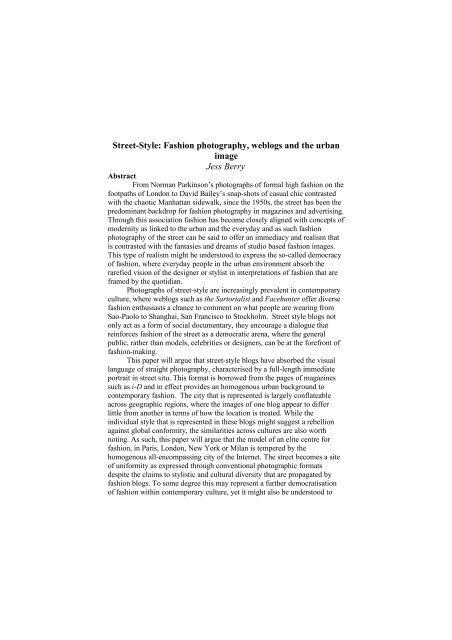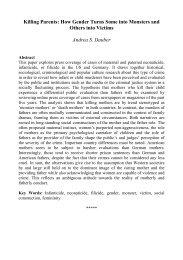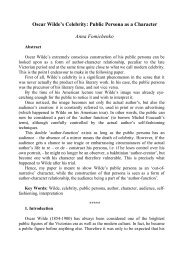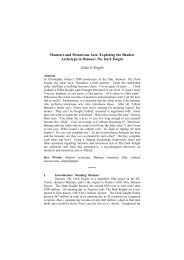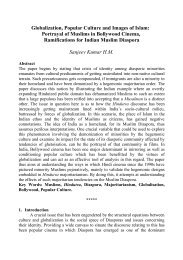Street-Style: Fashion photography, weblogs and the urban
Street-Style: Fashion photography, weblogs and the urban
Street-Style: Fashion photography, weblogs and the urban
Create successful ePaper yourself
Turn your PDF publications into a flip-book with our unique Google optimized e-Paper software.
<strong>Street</strong>-<strong>Style</strong>: <strong>Fashion</strong> <strong>photography</strong>, <strong>weblogs</strong> <strong>and</strong> <strong>the</strong> <strong>urban</strong><br />
image<br />
Jess Berry<br />
Abstract<br />
From Norman Parkinson’s photographs of formal high fashion on <strong>the</strong><br />
footpaths of London to David Bailey’s snap-shots of casual chic contrasted<br />
with <strong>the</strong> chaotic Manhattan sidewalk, since <strong>the</strong> 1950s, <strong>the</strong> street has been <strong>the</strong><br />
predominant backdrop for fashion <strong>photography</strong> in magazines <strong>and</strong> advertising.<br />
Through this association fashion has become closely aligned with concepts of<br />
modernity as linked to <strong>the</strong> <strong>urban</strong> <strong>and</strong> <strong>the</strong> everyday <strong>and</strong> as such fashion<br />
<strong>photography</strong> of <strong>the</strong> street can be said to offer an immediacy <strong>and</strong> realism that<br />
is contrasted with <strong>the</strong> fantasies <strong>and</strong> dreams of studio based fashion images.<br />
This type of realism might be understood to express <strong>the</strong> so-called democracy<br />
of fashion, where everyday people in <strong>the</strong> <strong>urban</strong> environment absorb <strong>the</strong><br />
rarefied vision of <strong>the</strong> designer or stylist in interpretations of fashion that are<br />
framed by <strong>the</strong> quotidian.<br />
Photographs of street-style are increasingly prevalent in contemporary<br />
culture, where <strong>weblogs</strong> such as <strong>the</strong> Sartorialist <strong>and</strong> Facehunter offer diverse<br />
fashion enthusiasts a chance to comment on what people are wearing from<br />
Sao-Paolo to Shanghai, San Francisco to Stockholm. <strong>Street</strong> style blogs not<br />
only act as a form of social documentary, <strong>the</strong>y encourage a dialogue that<br />
reinforces fashion of <strong>the</strong> street as a democratic arena, where <strong>the</strong> general<br />
public, ra<strong>the</strong>r than models, celebrities or designers, can be at <strong>the</strong> forefront of<br />
fashion-making.<br />
This paper will argue that street-style blogs have absorbed <strong>the</strong> visual<br />
language of straight <strong>photography</strong>, characterised by a full-length immediate<br />
portrait in street situ. This format is borrowed from <strong>the</strong> pages of magazines<br />
such as i-D <strong>and</strong> in effect provides an homogenous <strong>urban</strong> background to<br />
contemporary fashion. The city that is represented is largely conflateable<br />
across geographic regions, where <strong>the</strong> images of one blog appear to differ<br />
little from ano<strong>the</strong>r in terms of how <strong>the</strong> location is treated. While <strong>the</strong><br />
individual style that is represented in <strong>the</strong>se blogs might suggest a rebellion<br />
against global conformity, <strong>the</strong> similarities across cultures are also worth<br />
noting. As such, this paper will argue that <strong>the</strong> model of an elite centre for<br />
fashion, in Paris, London, New York or Milan is tempered by <strong>the</strong><br />
homogenous all-encompassing city of <strong>the</strong> Internet. The street becomes a site<br />
of uniformity as expressed through conventional photographic formats<br />
despite <strong>the</strong> claims to stylistic <strong>and</strong> cultural diversity that are propagated by<br />
fashion blogs. To some degree this may represent a fur<strong>the</strong>r democratisation<br />
of fashion within contemporary culture, yet it might also be understood to
2<br />
<strong>Street</strong> <strong>Style</strong>: <strong>Fashion</strong> <strong>photography</strong>, web logs <strong>and</strong> <strong>the</strong> <strong>urban</strong> image<br />
______________________________________________________________<br />
threaten a flattening out of visual <strong>and</strong> cultural distinction to engender<br />
sameness.<br />
Key Words: <strong>Fashion</strong> cities, <strong>photography</strong>, street-style, blogs.<br />
*****<br />
<strong>Fashion</strong> <strong>and</strong> <strong>the</strong> city are inextricably linked where fashion is an intrinsic part<br />
of <strong>the</strong> performance of <strong>urban</strong> life <strong>and</strong> <strong>the</strong> city itself has played an important<br />
part in <strong>the</strong> mythologizing of fashion. Key fashion capitals, Paris, London,<br />
New York, Milan <strong>and</strong> Tokyo have been constituted as style centres through<br />
visual representation in magazines, advertising <strong>and</strong> film <strong>and</strong> as such hold a<br />
powerful position in <strong>the</strong> collective imagination as to <strong>the</strong> geographical<br />
locations of fashion. While traditional forms of fashion media have been<br />
central to this construction it can be extrapolated that <strong>the</strong> representation of<br />
particular cities in street-style fashion blogs contributes to this discourse.<br />
This paper will argue that where street-style blogs differ in <strong>the</strong>ir<br />
representation of fashion is in <strong>the</strong>ir conflation of fashion cities. Where<br />
locations not immediately associated with fashionability are visually rendered<br />
in <strong>the</strong> same way as <strong>the</strong> traditional fashion centres of style. The street has<br />
become a site of uniformity constructed by <strong>the</strong> particular mode of straight-up<br />
<strong>photography</strong> that has emerged in <strong>the</strong>se blogs. It will be argued that this may<br />
represent a fur<strong>the</strong>r democratisation of fashion within contemporary culture<br />
where <strong>the</strong> fashion capital has been decentralised within global fashion<br />
networks.<br />
1. Web 2.0 <strong>and</strong> <strong>the</strong> Decentralisation of <strong>Fashion</strong> Cities<br />
The concept of a fashion city suggests an international metropolis at<br />
<strong>the</strong> forefront of style. Parisian couture <strong>and</strong> its stylistic influence have long<br />
established <strong>the</strong> French capital as <strong>the</strong> world’s fashion capital. London, New<br />
York, Milan <strong>and</strong> Tokyo have similarly been positioned as significant centres<br />
for style. The study of fashion cities <strong>and</strong> <strong>the</strong>ir role in cultural <strong>and</strong> economic<br />
geography has become a topic of interest for fashion scholars <strong>and</strong> has been<br />
discussed recently in Christopher Breward <strong>and</strong> David Gilbert’s edited book<br />
<strong>Fashion</strong>’s World Cities (2006). The essays in this collection establish how<br />
global fashion capitals have been both materially <strong>and</strong> symbolically<br />
constructed through a complex dynamic of economic factors; such as <strong>the</strong>ir<br />
position within <strong>the</strong> global marketplace, production systems; including<br />
offshore manufacturing <strong>and</strong> local specialist networks, as well as through<br />
cultural underst<strong>and</strong>ings of fashion cities represented by <strong>the</strong> cinema <strong>and</strong><br />
fashion press.<br />
Gilbert draws on John Friedmann’s “world city hypo<strong>the</strong>sis” to discuss<br />
why some cities are “identified as central cites of global significance in<br />
fashion culture” 1 based on <strong>the</strong>ir economic significance to <strong>the</strong> global market.
Jess Berry<br />
______________________________________________________________<br />
He also highlights how <strong>the</strong> major fashion cities have been historically<br />
established,<br />
by <strong>the</strong> <strong>urban</strong> consumer revolution…by <strong>the</strong> economic <strong>and</strong><br />
symbolic systems of European imperialism, by <strong>the</strong><br />
development of rivalries between European fashion cities,<br />
by <strong>the</strong> growing influence of an American engagement with<br />
European fashion, <strong>and</strong> finally by <strong>the</strong> emergence of a<br />
distinctively modern fashion media system 2 .<br />
While Paris, London, New York, Milan <strong>and</strong> Tokyo have remained<br />
dominant locations within global fashion discourse new technologies <strong>and</strong><br />
emergent fashion cities such as Shanghai, Moscow <strong>and</strong> Jaipur threaten to<br />
destabilise <strong>the</strong> status of <strong>the</strong> traditional fashion capitals. Many emergent<br />
fashion cities have developed out of new middle class consumer markets in<br />
recently industrialised countries while o<strong>the</strong>rs have evolved out of existing<br />
consumer markets in transformed colonial capitals. This trend indicates a<br />
decentralisation <strong>and</strong> democratisation of fashion across global networks that<br />
can also be witnessed in <strong>the</strong> production <strong>and</strong> consumption of fashion through<br />
global Internet networks.<br />
According to sociologist Manuel Castells (2002) <strong>the</strong> Internet has<br />
fundamentally changed <strong>the</strong> spatial form of <strong>the</strong> city to include <strong>the</strong> network<br />
society of cyberspace 3 . As Mike Fea<strong>the</strong>rstone explains, <strong>the</strong> data city is “a<br />
means of construction to underst<strong>and</strong> <strong>the</strong> contemporary city, <strong>the</strong> global city…<br />
<strong>the</strong> internet as an architectural <strong>and</strong> human interactional frame in its own<br />
right” 4 he goes on to state that “with <strong>the</strong> electronic media of a networked<br />
world, instantaneous connections are possible which render physical spatial<br />
differences irrelevant” 5 . Michael Ogden has a similarly optimistic view of <strong>the</strong><br />
data city as “multidimensional, limitless, everywhere <strong>and</strong> nowhere” available<br />
to everyone 6 . Fea<strong>the</strong>rstone <strong>and</strong> Ogden’s sentiments highlight <strong>the</strong> democratic<br />
possibilities of <strong>the</strong> Internet as a result of <strong>the</strong> geographical expansion of <strong>the</strong><br />
global city to include this network society. These technological <strong>and</strong><br />
sociological developments have resulted in significant consequences for <strong>the</strong><br />
fashion system.<br />
The increased interactivity, file sharing <strong>and</strong> social networking<br />
characteristics of Web 2.0 7 have contributed to <strong>the</strong> globalisation of fashion<br />
production <strong>and</strong> consumption in <strong>the</strong> twenty-first century. As fashion <strong>the</strong>orist<br />
Jennifer Craik contends, new media technology has made fashion<br />
increasingly available to a wide spectrum of people around <strong>the</strong> globe where<br />
<strong>the</strong> Internet’s interactive opportunities have allowed users to engage with <strong>the</strong><br />
fashion system through on-line shopping, digital fashion gaming, <strong>the</strong><br />
streaming of runway shows <strong>and</strong> discussion on social networking sites 8 . The<br />
globalisation of <strong>the</strong> marketplace through Internet networks is also explored<br />
3
4<br />
<strong>Street</strong> <strong>Style</strong>: <strong>Fashion</strong> <strong>photography</strong>, web logs <strong>and</strong> <strong>the</strong> <strong>urban</strong> image<br />
______________________________________________________________<br />
by Laird Borrelli who highlights that fashion websites “act as br<strong>and</strong> building<br />
vehicles” <strong>and</strong> that on-line stores have redefined <strong>the</strong> shopping experience 9 .<br />
While <strong>the</strong> impact of information technology on <strong>the</strong> fashion industry is yet to<br />
be quantified it would seem that <strong>weblogs</strong> or blogs are of particular<br />
significance in <strong>the</strong> decentralisation <strong>and</strong> democratisation of fashion in <strong>the</strong><br />
twenty-first century.<br />
Blogs are frequently updated personal journals made available on <strong>the</strong><br />
Internet. <strong>Fashion</strong> blogs cover a diverse range of topics including runway<br />
trends, celebrity lifestyles <strong>and</strong> shopping advice. They offer access to fashion<br />
around <strong>the</strong> world <strong>and</strong> have become a major influence on <strong>the</strong> fashion industry.<br />
Eric Wilson of <strong>the</strong> New York Times cites <strong>the</strong> presence of bloggers at fashion<br />
events, <strong>the</strong> attraction of advertising revenue to blogspots <strong>and</strong> <strong>the</strong> recruitment<br />
of bloggers to traditional forms of fashion media as evidence of this trend 10 .<br />
<strong>Street</strong>-style fashion blogs such as <strong>the</strong> Sartorialist <strong>and</strong> Facehunter offer<br />
fashion mavens a chance to comment on what people are wearing from Sao-<br />
Paolo to Shanghai, San Francisco to Stockholm. As Yvan Rodic suggests of<br />
his blog, Facehunter, “<strong>the</strong> internet has ended <strong>the</strong> monopoly on information<br />
by <strong>the</strong> elite” where “a teenager in a small town in Serbia can be well<br />
informed” <strong>and</strong> street style fashion blogs offer a system where “<strong>the</strong>re is nomore<br />
top-tier <strong>and</strong> bottom rung, no more high-fashion vs. high street” 11 .<br />
<strong>Street</strong>-style blogs encourage a global dialogue that reinforces fashion of <strong>the</strong><br />
street as a democratic arena, where <strong>the</strong> general public, ra<strong>the</strong>r than models,<br />
celebrities or designers, can be at <strong>the</strong> forefront of fashion making. In <strong>the</strong>ir<br />
photographic coverage of emerging fashion cities, street-style blogs have also<br />
contributed to an extension of <strong>the</strong> democratisation of fashion through <strong>the</strong><br />
decentralisation of elite capitals of style.<br />
2. <strong>Fashion</strong> Photography <strong>and</strong> <strong>the</strong> Urban Image<br />
<strong>Fashion</strong> cities have been sanctified through <strong>the</strong>ir representation in<br />
films <strong>and</strong> <strong>the</strong> fashion media. The conceptualisation of dominant fashion<br />
centres extends beyond <strong>the</strong> economic consumption of clo<strong>the</strong>s where clichés<br />
such as ‘Parisienne chic’ or ‘swinging London’ hold cultural cache. The<br />
recent representation of New York as a fashion capital in <strong>the</strong> television show<br />
<strong>and</strong> movie Sex <strong>and</strong> <strong>the</strong> City is an example of <strong>the</strong> discourse of style that has<br />
grown around particular fashion capitals. Gilbert, argues that <strong>photography</strong><br />
can be seen to play a central role in <strong>the</strong> characterisation of fashion cities,<br />
stating that,<br />
The imagined cities of fashion press rhetoric become<br />
visualised as <strong>the</strong> city is presented as a fashion object by<br />
<strong>photography</strong>. <strong>Fashion</strong> <strong>photography</strong> has had a close<br />
relationship with <strong>the</strong> representations of cities on postcards<br />
<strong>and</strong> tourist guides. In both cases <strong>the</strong>re is value in those
Jess Berry<br />
______________________________________________________________<br />
symbols that are unambiguous identifiers of a particular<br />
city 12 .<br />
This observation is particularly true of fashion <strong>photography</strong> from <strong>the</strong><br />
1940s onwards when <strong>the</strong> street began to provide a predominant backdrop for<br />
<strong>the</strong> dynamic action of <strong>the</strong> model. Norman Parkinson’s photographs for<br />
Vogue during <strong>the</strong> 1940s <strong>and</strong> 1950s are a good example of Gilbert’s<br />
characterisation of <strong>the</strong> city where iconic city skylines <strong>and</strong> monuments are<br />
glamorous backdrops to fashion narratives. By <strong>the</strong> 1960s <strong>the</strong> idealistic<br />
postcard images of fashion in <strong>the</strong> city had given way to a more <strong>urban</strong><br />
aes<strong>the</strong>tic where <strong>the</strong> gritty streetscapes captured by photographers, such as<br />
David Bailey, demonstrated <strong>the</strong> increasing influence of youth subcultures <strong>and</strong><br />
high-street styles on fashion at this time.<br />
<strong>Fashion</strong> <strong>photography</strong> of <strong>the</strong> street appropriates <strong>the</strong> dynamism of <strong>the</strong><br />
city to suggest an immediacy <strong>and</strong> realism that is contrasted with <strong>the</strong> fantasies<br />
<strong>and</strong> dreams of many studio-based images. That is not to say that fashion<br />
<strong>photography</strong> of <strong>the</strong> street does not present a desirable image of glamour, only<br />
that this image is a more readily available experience of fashion in everyday<br />
contexts. While Olivier Zahm argues that fashion <strong>photography</strong> is considered<br />
“instinctively suspect of superficiality, inau<strong>the</strong>nticity <strong>and</strong> gratuitousness” 13 it<br />
would seem that fashion <strong>photography</strong> that engages with <strong>the</strong> realism of <strong>the</strong><br />
street is less likely to be characterised in this way. In engaging with this<br />
realist style, Elliott Smedley argues that, fashion <strong>photography</strong> has “stripped<br />
bare <strong>the</strong> fantasies <strong>and</strong> <strong>the</strong> superficial ideals that <strong>the</strong> fashion industry had<br />
formerly felt compelled to portray <strong>and</strong> disseminate” 14 . In this way <strong>the</strong> realist<br />
image of street-style <strong>photography</strong> might be understood to express <strong>the</strong><br />
democracy of fashion, where everyday people in <strong>the</strong> <strong>urban</strong> environment<br />
challenge <strong>the</strong> rarefied vision of <strong>the</strong> designer or stylist.<br />
The influence of street-style <strong>photography</strong> on this discourse of<br />
democratisation is worthy of consideration. <strong>Street</strong>-style fashion blogs such as<br />
The Sartorialist <strong>and</strong> Facehunter have absorbed <strong>the</strong> visual language of<br />
straight-up <strong>photography</strong>, characterised by a full-length immediate portrait in<br />
street situ. Precursors to <strong>the</strong> images of street style fashion blogs can be found<br />
in <strong>the</strong> Strictly series of photographs styled by Simon Foxton <strong>and</strong><br />
photographed by Jason Evans in 1991 for i-D magazine <strong>and</strong> Shoichi Aoki’s<br />
documentation of sub-culture fashion in <strong>the</strong> Harajuku district of Tokyo for<br />
FRUiTS magazine begun in 1997. Where images of street-style fashion differ<br />
from o<strong>the</strong>r photographic representations of fashion <strong>and</strong> <strong>the</strong> city is <strong>the</strong> absence<br />
of iconic symbols of location. In both Evan’s <strong>and</strong> Aoki’s photographs <strong>the</strong>re is<br />
little to indicate a specific <strong>urban</strong> environment. Whe<strong>the</strong>r it is redbrick<br />
architecture of sub<strong>urban</strong> London in <strong>the</strong> case of Evan’s images or <strong>the</strong> concrete<br />
high-rises that are <strong>the</strong> backdrop to Aoki’s photographs in Tokyo, in both<br />
instances <strong>the</strong> interpretation of particular location is reliant on <strong>the</strong> clothing<br />
5
6<br />
<strong>Street</strong> <strong>Style</strong>: <strong>Fashion</strong> <strong>photography</strong>, web logs <strong>and</strong> <strong>the</strong> <strong>urban</strong> image<br />
______________________________________________________________<br />
worn by <strong>the</strong> subject. The English country gentry’s attire depicted in Strictly<br />
or <strong>the</strong> distinctive sub-culture style of Harajuku illustrated in FRUiTS are <strong>the</strong><br />
only signs available as to <strong>the</strong> fashion city context <strong>and</strong> even <strong>the</strong>se are<br />
unreliable indicators of specific location given <strong>the</strong> global nature of style. This<br />
is in contrast to <strong>the</strong> markers of place that Gilbert identifies as accessorising<br />
<strong>the</strong> city in fashion <strong>photography</strong>, such as, “red buses, pillar boxes <strong>and</strong> black<br />
cabs or water hydrants, steam vents <strong>and</strong> yellow taxis” 15 .<br />
The city as backdrop in Evans <strong>and</strong> Aoki’s straight-up street style<br />
<strong>photography</strong> suggests a generalised metropolis ra<strong>the</strong>r than a distinctive<br />
geographic location. In <strong>the</strong> case of <strong>the</strong> street-style <strong>photography</strong> represented<br />
on fashion blogs <strong>the</strong> absence of iconic indicators of particular fashion cities<br />
suggests an homogenous <strong>urban</strong> background to contemporary fashion whe<strong>the</strong>r<br />
<strong>the</strong> centre of style represented is Milan or Moscow. The conflated fashion<br />
city represented in street-style blogs may in fact be an effect of <strong>the</strong> Internet’s<br />
role in <strong>the</strong> expansion of <strong>the</strong> geography of fashionability.<br />
3. <strong>Street</strong> <strong>Style</strong> <strong>Fashion</strong> Blogs<br />
In surveying <strong>the</strong> images from a range of fashion blogs, including <strong>the</strong><br />
Sartorialist, Facehunter, Stylites, hel-looks, lookatme, <strong>Street</strong>aholic Shanghai<br />
<strong>and</strong> wearabout a number of similarities can be found. Perhaps <strong>the</strong> most<br />
significant connection between <strong>the</strong>se blogs, that cover both traditional<br />
fashion capitals <strong>and</strong> emerging fashion cities, is that a diverse array of people<br />
are represented, spanning different socio-economic groups, ages <strong>and</strong><br />
nationalities. One of <strong>the</strong> shared underlying strategies of <strong>the</strong>se blogs is to<br />
demonstrate how fashion is expressed in <strong>the</strong> city street ra<strong>the</strong>r than <strong>the</strong><br />
catwalk <strong>and</strong> as such <strong>the</strong>y portray fashion as increasingly democratic <strong>and</strong><br />
accessible to people around <strong>the</strong> world. Though of course <strong>the</strong>re is still an<br />
element of exclusion when not all countries, cities <strong>and</strong> people have access to<br />
<strong>the</strong> Internet so are not able to engage with this global fashion community.<br />
<strong>Street</strong>-style fashion blogs illustrate <strong>the</strong> complicated <strong>and</strong><br />
contradictory nature of fashion trends within globalised networks. Mass<br />
produced fashion appears ubiquitous across cultures however <strong>the</strong>re are also<br />
considerable differences in styles worn by people within <strong>the</strong> same city. As<br />
Craik argues, <strong>the</strong>re is a “tension between global zeitgeist <strong>and</strong> its propulsion<br />
of local cultures to differentiate <strong>the</strong>mselves through distinctive fashion<br />
statements <strong>and</strong> local variants” 16 . Uma Kothari <strong>and</strong> Nina Laurie identify <strong>the</strong><br />
impact of globalisation on fashion suggesting that Western influence has<br />
produced a situation where “different bodies where <strong>the</strong> same clo<strong>the</strong>s” 17<br />
within different cultural contexts <strong>and</strong> imply that issues of cultural<br />
imperialism continue to influence <strong>the</strong> dissemination of fashion. However,<br />
Peter Jackson, Nicola Thomas & Claire Dwyer suggest that <strong>the</strong> process of<br />
globalisation is subject to distinct local variations. They argue that instead of
Jess Berry<br />
______________________________________________________________<br />
homogeneity, globalisation has created fashion hybridity <strong>and</strong><br />
challenges,<br />
<strong>the</strong> essentialist view that sees cultural au<strong>the</strong>nticity as <strong>the</strong><br />
innate property of a particular group or product…instead<br />
that <strong>the</strong> meaning of goods is contingent on how those goods<br />
are appropriated within specific contexts of use 18 .<br />
The fashion depicted on street-style blogs appears to illustrate this<br />
view to a degree. For <strong>the</strong> creator of <strong>the</strong> Facehunter blog, Yvan Rodic<br />
“globalisation is a myth” <strong>and</strong> instead what is represented on his blog is what<br />
he calls <strong>the</strong> “New Creole Culture” where his subjects “share a lust for <strong>the</strong><br />
customisation of <strong>the</strong>ir identities with fragments of culture from different parts<br />
of <strong>the</strong> world” 19 . An example of this style can be seen in Rodic’s May 29,<br />
2010 post New York –james, Crosby street, 5/10/10. Here <strong>the</strong> young man<br />
combines different aspects of religious dress, current <strong>urban</strong> trends <strong>and</strong> subcultural<br />
style by wearing a military style jacket, pedal pushers, Doc Martin<br />
boots <strong>and</strong> a Sikh patka t<strong>urban</strong>. It is an ensemble that demonstrates that<br />
individual style can be established through customisation <strong>and</strong> local uses of<br />
fashion. Globalised fashion appears in this context to be a complex mix of<br />
global <strong>and</strong> local influences, along with traditional <strong>and</strong> modern elements.<br />
While <strong>the</strong> individual style that is represented in <strong>the</strong>se blogs might<br />
suggest a rebellion against global conformity, similarities across cultures are<br />
also worth noting, <strong>and</strong> are emphasised by <strong>the</strong> city acting as a unifying <strong>and</strong><br />
uniform backdrop to <strong>the</strong>se hybrid styles. The Internet erodes <strong>the</strong> potency of<br />
fashion capitals as geographic centres of style by offering a city that is<br />
everywhere <strong>and</strong> nowhere. The de-centralisation of <strong>the</strong> traditional fashion city<br />
is fur<strong>the</strong>r compounded by <strong>the</strong> visual consistency of location constructed<br />
through street-style blog <strong>photography</strong> that similarly renders <strong>the</strong> city as<br />
homogenous <strong>and</strong> without distinction. Overwhelmingly <strong>the</strong>se images are<br />
notable for <strong>the</strong>ir lack of distinguishing l<strong>and</strong>marks. There are few visual cues<br />
represented to suggest a particular geographical location, instead <strong>the</strong>y share a<br />
visual language of <strong>urban</strong> space that provides limited cultural context for <strong>the</strong><br />
fashions portrayed. Fur<strong>the</strong>rmore, <strong>the</strong>se disparate <strong>urban</strong> spaces are not only<br />
treated in <strong>the</strong> same way in any one blog, which would suggest <strong>the</strong> stylistic<br />
agenda of an individual photographer, but ra<strong>the</strong>r share a similar aes<strong>the</strong>tic<br />
across blogs. For example, <strong>the</strong> Sartorialist Scott Schuman’s images in Paris<br />
are comparable to those of Nels Frye for Stylites’ photographs in Beijing. The<br />
recurring vistas of brick walls, concrete pavements <strong>and</strong> <strong>urban</strong> streetscapes<br />
that we see on so many of <strong>the</strong>se sites provide a background closer to <strong>the</strong><br />
imagery of social documentary <strong>photography</strong> than to traditional fashion<br />
formats or tourist postcards.<br />
7
8<br />
<strong>Street</strong> <strong>Style</strong>: <strong>Fashion</strong> <strong>photography</strong>, web logs <strong>and</strong> <strong>the</strong> <strong>urban</strong> image<br />
______________________________________________________________<br />
Straight-up <strong>photography</strong> provides a neutral background to observe<br />
<strong>and</strong> demarcate <strong>the</strong> diversity of street-style fashion trends however, in doing<br />
so it relies on an homogenous image of <strong>the</strong> city constructed through <strong>the</strong><br />
uniformity of <strong>the</strong> photographic format. It seems contradictory for street-style<br />
blogs with <strong>the</strong>ir claims to immediacy, individuality <strong>and</strong> limitlessness to<br />
depict <strong>the</strong> city in such a consistent way as to engender a cultural sameness.<br />
While <strong>the</strong> agenda of <strong>the</strong>se blogs appears to be <strong>the</strong> celebration of <strong>the</strong><br />
multifarious <strong>and</strong> unique nature of global style this is in contradistinction to<br />
<strong>the</strong> manufacturing of fashionability achieved through <strong>the</strong> way that<br />
<strong>photography</strong> is used to render fashion capitals <strong>and</strong> non-fashion cities<br />
identical.<br />
4. Conclusions<br />
This paper has argued that <strong>Street</strong>-style blogs demonstrate how <strong>the</strong><br />
global influences of fashion have been localised <strong>and</strong> individualised within<br />
particular geographic locations. The homogenising effects of globalisation on<br />
fashion styles may be less prevalent than previously thought with <strong>the</strong><br />
hybridisation of fashion being a more accurate reflection of consumption<br />
within global networks. While particular styles of fashion might be<br />
represented as unique by street-style blogs <strong>the</strong> converse is true of <strong>the</strong>ir<br />
representation of fashion cities, where traditional fashion capitals are visually<br />
represented in <strong>the</strong> same way as emergent fashion cities.<br />
The mythology of elite fashion capitals associated with <strong>the</strong>ir<br />
photographic representation has been tempered by <strong>the</strong> uniform representation<br />
of <strong>the</strong> city in street-style blogs. The realism that street-style blogs engage<br />
with can be seen to ‘re-socialise’ fashion outside <strong>the</strong> fantasy narratives<br />
provided by consumer capitalism <strong>and</strong> this decentralisation of fashion might<br />
be seen as an extension of fashion’s democracy in contemporary culture.<br />
However, if street-style blogs have established a photographic convention<br />
that renders <strong>the</strong> city as <strong>the</strong> everywhere <strong>and</strong> nowhere backdrop to fashion that<br />
indicates cultural sameness, <strong>the</strong> result might be a manufacturing of style that<br />
is devoid of narrative <strong>and</strong> individuality.
Jess Berry<br />
______________________________________________________________<br />
Notes<br />
9
1 Gilbert, D ‘From Paris to Shanghai: <strong>the</strong> Changing Geographies of <strong>Fashion</strong>’s World Cities’ in C Breward <strong>and</strong> D Gibert<br />
(eds), <strong>Fashion</strong>’s World Cities, Berg, Oxford, 2006, p. 6.<br />
2 Gilbert, op.cit., 2006, p.19.<br />
3 Castells, M ‘Local <strong>and</strong> Global: Cities in <strong>the</strong> Network Society’ Tijdschrift voor Economische en Sociale Geografie, Vol. 93,<br />
No 5, 2000, p.548<br />
4 Fea<strong>the</strong>rstone, M ‘The Flâneur, <strong>the</strong> City <strong>and</strong> Virtual Public Life’ Urban Studies Vol.35, No.5-6, 1998, p.910<br />
5 ibid, p. 921.<br />
6 Ogden, M cited in Aurigi, A Making <strong>the</strong> Digital City: <strong>the</strong> early shaping of Urban Internet space, Ashgate, London, 2005,<br />
p.19.<br />
7 Lindgren, S ‘From Flâneur to Web Surfer: Videoblogging photosharing <strong>and</strong> Walter Benjamin @ <strong>the</strong> Web 2.0’<br />
Transformations, No. 15, Nov. 2007, viewed on 25 May 2010,<br />
http://transformationsjournal.org/journal/issue_15/article_10.html<br />
8 Craik, J <strong>Fashion</strong>: <strong>the</strong> Key Concepts, Berg, Oxford, 2009, p.270.<br />
9 Borrelli, L Net Mode: Web <strong>Fashion</strong> Now, Thames <strong>and</strong> Hudson, New York, 2002, p.6.<br />
10 Wilson, E ‘Bloggers Crash <strong>Fashion</strong>’s Front Row’ The New York Times, December 24, 2009, viewed on May 18, 2010,<br />
http://www.nytimes.com/2009/12/27/fashion/27BLOGGERS.html<br />
11 Rodic, Y Facehunter, Thames & Hudson, London, 2010, p.7.<br />
12 Gilbert, D ‘Urban Outfitting: <strong>the</strong> city <strong>and</strong> <strong>the</strong> spaces of fashion culture’ in S Bruzzi & O Gibson (eds), <strong>Fashion</strong> Cultures:<br />
Theories, Explorations <strong>and</strong> Analysis, Routlegde, London, 2000, p.21.<br />
13 Zham, O ‘On <strong>the</strong> Marked Change in <strong>Fashion</strong> Photography” in U Lehmann (ed), Chic Clicks, Hatje Cantz<strong>and</strong> The<br />
Institute of Contemporary Art, Boston, 2000, p. T29.<br />
14 Smedley, E ‘Escaping to Reality: <strong>Fashion</strong> <strong>photography</strong> in <strong>the</strong> 1990s’ in S Bruzzi & O Gibson (eds), <strong>Fashion</strong> Cultures:<br />
Theories, Explorations <strong>and</strong> Analysis, Routlegde, London, 2000, p. 148.<br />
15 Gilbert op.cit., 2000, p. 21.<br />
16 Craik, op.cit., 2009, p. 301.<br />
17 Kothari, U & Laurie, N ‘Different Bodies, same clo<strong>the</strong>s: an agenda for local consumption <strong>and</strong> global identites’ Area, Vol.<br />
37, No.2, 2005, pp.225<br />
18 Jackson, P, Thomas, N & Dwyer, C ‘Consuming Transnational <strong>Fashion</strong> in London <strong>and</strong> Mumbai’ Geoform, Vol. 38, 2007,<br />
p. 918.<br />
19 Rodic op.cit., 2010, p.7.<br />
References<br />
Aurigi, A Making <strong>the</strong> Digital City: <strong>the</strong> early shaping of <strong>urban</strong> Internet space, Ashgate, London, 2005.<br />
Berry, S ‘<strong>Fashion</strong> <strong>and</strong> Personalisation on <strong>the</strong> Web’ in S Bruzzi & O Gibson (eds), <strong>Fashion</strong> Cultures: Theories, Explorations<br />
<strong>and</strong> Analysis, Routledge, London, 2000<br />
Breward, C & Gilbert, D (eds.) <strong>Fashion</strong>’s World Cities, Berg, Oxford, 2006.<br />
Borrelli, L Net Mode: Web <strong>Fashion</strong> Now, Thames <strong>and</strong> Hudson, New York, 2002.<br />
Castells, M ‘Local <strong>and</strong> Global: Cities in <strong>the</strong> Network Society’ Tijdschrift voor Economische en Sociale Geografie, Vol.93,<br />
No 5, 2000, pp.548-558.<br />
Craik, J <strong>Fashion</strong>: <strong>the</strong> Key Concepts, Berg, Oxford, 2009, p.270.<br />
Fea<strong>the</strong>rstone, M ‘The Flâneur, <strong>the</strong> City <strong>and</strong> Virtual Public Life’ Urban Studies Vol.35, No.5-6, 1998,p p. 909-925.<br />
Gilbert, D ‘From Paris to Shanghai: <strong>the</strong> Changing Geographies of <strong>Fashion</strong>’s World Cities’ in C Breward <strong>and</strong> D Gibert (eds),<br />
<strong>Fashion</strong>’s World Cities, Berg, Oxford, 2006.<br />
Gilbert, D ‘Urban Outfitting: <strong>the</strong> city <strong>and</strong> <strong>the</strong> spaces of fashion culture’ in S Bruzzi & O Gibson (eds), <strong>Fashion</strong> Cultures:<br />
Theories, Explorations <strong>and</strong> Analysis, Routlegde, London, 2000.<br />
Jackson, P, Thomas, N & Dwyer, C ‘Consuming Transnational <strong>Fashion</strong> in London <strong>and</strong> Mumbai’ Geoform, Vol. 38, 2007, p.<br />
908-924.
Kothari, U & Laurie, N ‘Different Bodies, same clo<strong>the</strong>s: an agenda for local consumption <strong>and</strong> global identites’ Area, Vol.<br />
37, No.2, 2005, pp.223-227<br />
Rodic, Y Facehunter, Thames & Hudson, London, 2010.<br />
Smedley, E ‘Escaping to Reality: <strong>Fashion</strong> <strong>photography</strong> in <strong>the</strong> 1990s’ in S Bruzzi & O Gibson (eds), <strong>Fashion</strong> Cultures:<br />
Theories, Explorations <strong>and</strong> Analysis, Routlegde, London, 2000, p. 148.<br />
Wilson, E ‘Bloggers Crash <strong>Fashion</strong>’s Front Row’ The New York Times, December 24, 2009, viewed on May 18, 2010,<br />
http://www.nytimes.com/2009/12/27/fashion/27BLOGGERS.html<br />
Zham, O ‘On <strong>the</strong> Marked Change in <strong>Fashion</strong> Photography” in U Lehmann (ed), Chic Clicks, Hatje Cantz <strong>and</strong> The Institute<br />
of Contemporary Art, Boston, 2000.<br />
Dr Jess Berry is Lecturer in Art <strong>and</strong> Design History <strong>and</strong> Theory, Queensl<strong>and</strong> College of Art, Griffith University, Australia.


